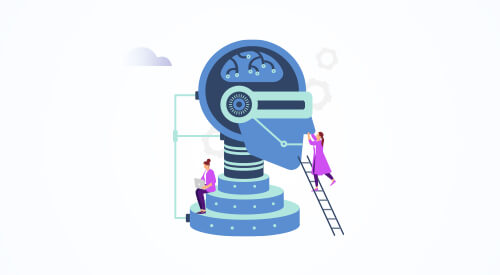

Deep learning, a branch of AI, plays a crucial role in analyzing vast amounts of information and identifying patterns within it. Unlike traditional machine learning, which requires manual engineering of the input feature set, deep learning leverages multi-layered neural networks to automatically learn from data. This capability makes it highly valuable across industries like healthcare and autonomous systems manufacturing, where raw data must be processed and categorized. In fact, deep learning techniques are responsible for generating 40% of the annual value created by analytics, according to McKinsey.
Explore ML Solutions with Niveus Solutions
In this blog, we will explore the fundamentals of deep learning, its applications across various industries, and the challenges that come with implementing this advanced AI technology. We will also discuss how businesses can leverage deep learning to improve decision-making, optimize processes, and stay competitive in an increasingly data-driven world.
What is Deep Learning?
Deep learning is a subset of machine learning, where algorithms are structured to mimic the human brain’s neural networks. While traditional machine learning requires predefined features, deep learning allows the system to learn these features autonomously from the data, making it more adaptable and scalable. The layers of neurons in deep learning models, known as deep neural networks (DNNs), enable the processing of complex data, leading to advanced capabilities like image recognition, natural language understanding, and predictive analytics.
Types of Deep Learning
Deep learning consists of several categories of models that are created to address certain types of challenges. These models vary with regards to the structures that compose them and the approaches that are normally used in handling raw information. It is important to understand the differences between the types of deep learning in order to apply it in businesses appropriately.
Convolutional Neural Networks (CNNs)
Convolutional Neural Network (CNN) is normally used in tasks involving image and video recognition. CNNs work like the human perception system by splitting the image features into several parts and processing them step by step. This helps the model capture space hierarchies and pattern recognition and as a result makes CNNs valuable when used in medical imaging and face or object identification to auto-driving capabilities.
Recurrent Neural Networks (RNNs)
Recurrent Neural Networks (RNNs) are the type of network that is intended to work with sequences. Compared to other models, RNNs are capable of preserving prior input information, which is useful for problems such as time series and NLP. RNNs can memorize previous inputs in a way that other neural networks cannot, allowing the analysis of complicated data over time.
Generative Adversarial Networks (GANs)
Generative Adversarial Networks (GANs) consist of two neural networks that work in tandem: One of them creates data while the other analyzes it. This kind of force play makes GANs able to generate realistic data like images, text, or even videos. Uses of GANs deep learning applications inclusive of media, entertainment, and autonomous vehicles industries where synthetic data is created to mimic real-world situations.
Machine Learning and Deep Learning: Key Differences
Machine learning and deep learning are often discussed together, but they have distinct differences that impact how they are applied. While both fall under the broader umbrella of AI, understanding these differences helps businesses decide which technology is more suited to their specific needs.
Machine Learning vs. Deep Learning: A Comparison
While machine learning uses pre-established algorithms that must be manually fed with features from data, deep learning uses neural networks to learn features. Machine learning models require lesser training time compared to deep learning models and are not as effective for handling structured data such as images and voice. While deep learning models require higher computational power and data, they outperform other models in cases where extensive and real-time decisions and predictive models are required. For companies that work with vast amounts of data, deep learning is also more scalable and accurate, which is important in such fields as medicine and finance.
Integration of Machine Learning and Deep Learning
Although the difference exists, machine learning and deep learning can work in conjunction. Some organizations use matrices where machine learning is used to solve basic problems while deep learning to solve more complicated issues. It also means that solutions with AI integrated are better, overall, because they are able to provide a more holistic approach. For instance, in a machine learning setup, a data mining step may screen information to be processed, and this is forwarded to a deep learning stage to give better, real-time analysis.
Deep Learning Applications Across Industries
Deep learning has transformed the way businesses operate by automating processes and enhancing decision-making. Its flexibility allows it to be applied across a wide range of industries, from healthcare to finance, improving accuracy and efficiency. In this section, we will look at key industries where deep learning applications have made a significant impact.
Healthcare
In healthcare, deep learning is already used in the diagnosis of diseases, with prognostic capabilities of patient status, and targeted treatment interventions. Modern application of deep learning is seen in medical imaging where convolutional neural networks (CNNs) are used in diagnosing patients from their X-rays, MRI and CT scans. These models are more sensitive than even experienced radiologists and often result in quicker diagnosis.
Finance
Within the financial industry, use cases of deep learning include fraud detection, algorithmic trading, and risk management. Since deep learning can handle vast amounts of transactional data, the models use them to detect fraudulent behavior effectively. Another popular application is the use of Recurrent Neural Networks (RNNs) in the identification of anomalous patterns in the time series data that can enable financial institutions to manage the risks and safeguard their customers. Furthermore, deep learning applications have been prevalent in the field of algorithmic trading, where the models use data feed from the market to make trading decisions in real time.
Autonomous Systems
Real-life autonomous operating vehicles like cars, drones and industrial robots, among others, are benefitting from deep learning models in making decisions in a real-time environment. CNNs and RNNs are central to processing the sensor data to detect objects and to forecast various results. For instance, self-driving cars rely on deep learning algorithms to identify pedestrians, other cars and traffic signals, and make decisions in real time.
Challenges and Ethical Considerations in Deep Learning
As deep learning continues to advance, several challenges and ethical issues must be addressed to ensure that it is deployed responsibly. These challenges primarily revolve around data privacy, model transparency, and ensuring fairness in AI-driven decisions.
Data Privacy and Security
Deep learning models involve huge amounts of data in their operations and many of the datasets could be of private nature. This is due to the virtue of their sensitivity and the protection of private information hence prompt rise to health and financial sectors. Any business that is operating within the deep learning context must guarantee the security of the data collected as well as its compliance to laws of data protection. To reduce such risks some measures may include – encrypting the data, anonymization techniques, and enhanced security measures. Nevertheless, the problem of how better to balance the requirement for more significant datasets against privacy continuities persists.
Model Explainability and Transparency
One of the well-known drawbacks of deep learning is the fact that the results of its work cannot be directly explained, which is known as the “black-box” issue. Interpretation of how deep learning models reach certain conclusions is cumbersome, something that is unhelpful in fields where interpretation is paramount, say in healthcare and finance. In many cases, regulatory needs necessitate transparency and explainability of the decision-making performed by various AI systems. This has resulted in the evolution of explainable Artificial Intelligence methods and systems whose primary goal is to enhance the interpretability of deep learning models. Thus, organizations implementing the deep learning approaches should aim at applying these techniques to increase trust and meet the requirements of the regulations.
Ethical AI and Fairness
Specifically, the problem of biased representation in the training dataset can translate to unfair outputs when training and using a deep learning model. This is so especially when it comes to areas like employment, credit, and policing where AI decisions may actually impact lives. It also says that the process of being fair towards AI involves paying attention to the kind of data that are used in building the models, as well as constantly assessing the models to ensure that they are not reinforcing bias. Thus, the concerns over AI injustice also apply to companies deploying deep learning, with appropriate measures needed to protect against this issue.
Conclusion
Deep learning technique is one of the most promising techniques which is increasingly being applied to most fields and has drastically changed the scope of artificial intelligence. Owing to its capacities for processing and analyzing big amounts of information, deep learning offerings are contributing to the social progress in the spheres of healthcare, finance, transport, and others. But they should also be aware of the controversies and key issues to deep learning which includes data privacy, model interpretability, and biasness. Things like above mentioned are instrumental in ensuring that these firms fully unlock deep learning for growth and better operations given that they know the current trends and advances in the industry.
That is why at Niveus Solutions, we focus on creating high-quality and complex ML models that will be ideal for our clients. Be it process automation, better decision making, customer experience, our skills in ML and AI will enable companies to identify potential opportunities for growth and remain relevant in the market.









